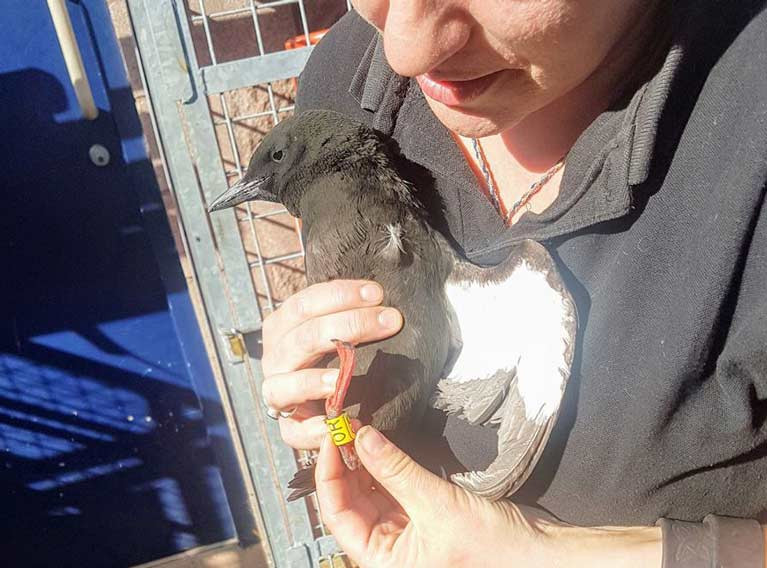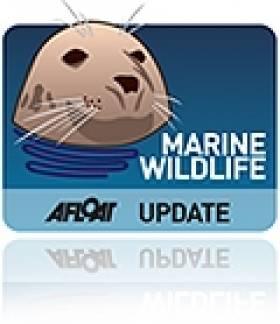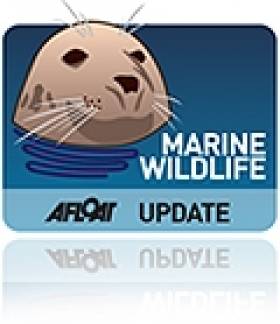Displaying items by tag: Marine Widlife
Fair Seas' Film Shines Light on Northwest Coastal Communities and Urges Marine Conservation Action
The Northern Ireland Inheritance Film Festival is set to feature the online premiere of 'Fair Seas: The Atlantic Northwest', a short film that showcases the perspectives of coastal communities from Donegal and Sligo who rely on the sea for their livelihood. Fair Seas produced the 14-minute documentary, which offers insights into the hopes, fears, and stories of local seafood producers, an angler, a diving instructor, and a walking guide throughout the North Donegal to Sligo region. The film highlights how the creation of Marine Protected Areas could provide a fresh approach to maritime life conservation that has supported these communities for generations.
The maritime region of Northwest is home to over 25 species of whales and dolphins, 38 species of seabirds, and a variety of rare and endangered species of sharks, skates, and rays. The adverse impact of climate change, pollution, a loss of biodiversity, and reduced fish stocks throughout the region are worth mentioning.
 Peter McAuley filming with the Swimming Head Productions team
Peter McAuley filming with the Swimming Head Productions team
Fair Seas is campaigning for strong and ambitious Marine Protected Areas (MPA) legislation to be published as soon as possible to protect this vital resource and the coastal communities of Donegal and Sligo that rely on it. The group wants to see mandatory targets committing to effectively protecting 30% of the seas around Ireland by 2030 with 10% strictly protected. Fair Seas is calling for stakeholder engagement at every stage of the MPA designation with clear delivery timeframes as well as a robust management framework which clearly defines the varying degrees of site protection to ensure MPAs deliver for nature.
Aoife O’Mahony, Campaign Manager with Fair Seas said, “The Northwest coastline is breathtaking and our latest film explores some of the wildlife and biodiversity hidden beneath the waves. It is really important for us to hear the views of the people who make a living from the sea and to hear their concerns about the health of the ocean. There is also plenty of reason for hope and we all can act to make a difference. Donegal is famous for the large number of basking sharks that can be seen in its waters. This gentle giant was hunted nearly to extinction, now it is a protected species in Irish waters and making a comeback thanks to widespread public support.”
“Time is running out for Ireland to meet its targets to protect 30% of our seas and ocean by 2030. The Marine Protected Area Bill was promised in June 2023 and we are still waiting to see this crucial legislation. We’re asking the voters of Ireland’s Atlantic Northwest and across the country to add their voice to the calls to safeguard our seas, tell your elected representatives you want strong and ambitious marine protected area legislation. We must all act with ambition and urgency so that the full benefits of nature restored can reveal themselves in generations to come.”
Inheritance is an environmental festival which takes place three times a year. It aims to educate, inspire and raise awareness of contemporary environmental issues, and to showcase the work of independent filmmakers from all over the globe. The festival is live-streamed on the Inheritance website and screened on regional TV channels including Latest TV in Brighton, Northern Visions in Belfast, Sheffield Live! in Sheffield and KMTV in Kent.
 The Fair Seas film will be shown on Belfast’s NVTV on Sunday, September 23rd from 9pm. The channel is available on Freeview 7 and Virgin Media 159, in Belfast, and nvtv.co.uk/livestream.
The Fair Seas film will be shown on Belfast’s NVTV on Sunday, September 23rd from 9pm. The channel is available on Freeview 7 and Virgin Media 159, in Belfast, and nvtv.co.uk/livestream.
‘Fair Seas: The Atlantic Northwest’ was part funded by the Networking and Marine Research Communications Awards, funded by the Marine Institute under the Marine Research Programme with the support of the Irish Government.
It was produced by Swimming Head Productions, an award-winning team specialising in quick-fire documentaries with a focus on heritage, science and the natural world.
Fair Seas has also produced a new postcard for Ireland’s Northwest Coast which features a basking shark swimming over a bed of seagrass. This postcard will be shared with ocean conservation organisations in this local area to highlight the beauty of this area of Ireland’s Coast.
Invasive Crayfish's Ability to Adapt to Cold Water Environments Identified By Japanese Scientists
Molecular mechanisms that allowed a type of tropical crayfish to become a global invasive species by adapting to colder water have been identified by scientists in Japan.
The research is relevant to growing concerns about animal species colonising new habitats across the globe, with devastating impacts on local biodiversity.
A paper published in the journal iScience explains that recently discovered genes may help the red swamp crayfish to produce protective proteins which allow them to adapt to the cold.
The red swamp crayfish—known to the scientific world as Procambarus clarkii (P. clarkii)— is a freshwater species native to the tropical regions of southern USA and northeastern Mexico.
These particular crayfish have become one of the most widespread and invasive animal species, the researchers note.
They are known for their “adaptability and aggressive behaviour that ensure their survival in a wide range of environments, even in regions much colder than their original habitats”.
A group of researchers from Japan, including Dr Daiki Sato, assistant professor at the Graduate School of Science of Chiba University, and Professor Takashi Makino from Tohoku University focused on crayfish settling Sapporo city in central Hokkaido, where water temperatures are extremely low during the winter.
They sought to study the genetic changes that have allowed the crayfish to adapt to these cold environments.
“A population of red swamp crayfish in Sapporo, Japan may have acquired genetic changes that enhanced its cold tolerance. We have revealed the genes and genomic architecture possibly involved in the cold adaptation mechanism,”Dr Sato said.
“Although the red swamp crayfish has been a well-known and notorious invasive species in Japan for quite some time, nobody has examined its genomic and transcriptomic characteristics that contribute to its invasiveness yet, thus motivating us to pursue this study,” Prof Makino, who led the study, said.
“We feel our study has far-reaching ecological implications,” he said.
“Overall, these findings significantly contribute to our understanding of invasive species, which may help us take measures to prevent their spread and, in turn, protect global biodiversity,” the researchers said.
Their study was made available online on July 3rd, 2023, and will be published in Volume 26, Issue 8 of the journal iScience on August 18, 2023.
All But One Irish Avian Flu Cases Are Seabirds
The Department of Marine has announced the introduction of regulations under the Animal Health and Welfare Act 2013 requiring flock keepers to apply particular bio-security measures for poultry and other captive birds as a precautionary measure against Highly Pathogenic Avian Influenza (HPAI). These precautionary measures against avian influenza (bird flu) come into effect on 19 September 2022.
Since July of this year, over 80 wild birds were submitted to the Department’s laboratories for testing. Of these almost 60 positive highly pathogenic avian influenza (HPAI) cases were confirmed, all are subtype H5N1. To date, all but one have been seabirds, including gannets in counties Cork, Kerry, Mayo, Dublin, Donegal, Louth and Waterford, a raven in Kerry and a guillemot in Donegal. These wild bird findings confirm that the avian influenza virus is currently circulating widely in the wild bird population in Ireland. This reservoir of infection in wildlife poses a risk to our poultry flocks and industry. There have not been any outbreaks in poultry flocks, at this time. Strict biosecurity measures to prevent contact between kept and wild birds is key to protecting poultry and other captive birds.
These Regulations require specific biosecurity measures to be implemented by the keepers of all poultry (and other captive bird) flocks, irrespective of size, to help mitigate the risk of infection of their poultry from the virus and additionally, in respect of flocks of 500 birds or more, the implementation of further enhanced biosecurity measures by flock-owners.
All poultry flock owners should remain vigilant for any signs of disease in their flocks, maintain strict biosecurity measures and report any disease suspicion to their nearest Department Regional Veterinary Office, even if they only have one or two birds.
The HPAI H5N1 subtype has been responsible for disease in wild birds and outbreaks in poultry and captive birds in a number of EU Member States and Great Britain. The Department is working closely with colleagues in the Department of Agriculture, Environment and Rural Affairs in Northern Ireland (DAERA), National Parks and Wildlife Services (NPWS), Local Authorities, the HPSC and HSE regarding avian influenza.
The Health Protection Surveillance Centre has confirmed that although the HPAI H5N1 subtype can cause serious disease in poultry and other birds, no human infections with this virus have been reported in the EU and therefore risk to humans is considered to be very low. Properly cooked poultry and poultry products, including eggs are safe to eat.
Members of the public are advised not to handle sick or dead wild birds and to report any episodes of sick or dead wild birds to the Regional Veterinary Office or contact the DAFM disease helpline on 014928026. An early warning system is in place with Birdwatch Ireland, the National Parks and Wildlife Service and the National Association of Regional Game Councils with regard to surveillance for signs of disease in wild birds.
The Department continues to closely monitor and assess the disease situation and is in regular contact with industry stakeholders.
Hen Harrier, Curlew & Corncrake The Focus of Biodiversity Crisis Webinar
Once far more familiar in coastal areas, three of Ireland’s most endangered birds are the subject of a webinar hosted today by the Irish Wildlife Trust (IWT).
The threats posed to and monitoring projects on the curlew, the corncrake and the hen harrier will be discussed at the “Birds on the Edge” event by experts in these fields.
Galway-Mayo Institute of Technology researcher Ryan Wilson-Parr will speak about the Hen Harrier Project, while Kathryn Finney of BirdWatch Ireland and John Carey of the recently-launched Corncrake LIFE project will talk about the curlew and corncrake populations.
The event is part of a series of webinars which the IWT is running on solutions to the biodiversity crisis in Ireland.
Sightings of the birds are monitored by various surveys and on the online recording portal Birdtrack, which Birdwatch Ireland participates in along with the British Ornithology Trust and other partners.
Details of Birdtrack are here
Registration for the webinar, which is free and takes place today, February 1st, at 7 pm, is here
And more details on IWT webinars here
Bangor Harbour is Alive With Marine Wildlife
Harbours by their nature attract a myriad of marine wildlife and Bangor on Belfast Lough is no exception. Most people would associate Bangor with the guillemots that make their nests in holes in the marina wall but there is so much more.
The guillemots have been there for over one hundred years and have been fondly nicknamed "Bangor penguins" by residents. They have even given their name to a nearby café. Not only are they watched but recently an injured bird was sent to A and E! It is now in the safe hands of Debbie Dolittle's Wildlife rescue centre in Antrim, to have a splint on its leg.
 A Guillemot in Bangor Harbour
A Guillemot in Bangor Harbour
The most recent activity was the fledging of Rock Pipits from a nest in the inside of the Long Hole breakwater. The Long Hole used to be full of small craft but since the marina was built, is now empty. A resident in the nearby Clifdene Apartments using a powerful telescope could see right into the nest. She noticed the chicks coming out of the nest to exercise and they looked quite big, so it was no surprise when there was no activity last Saturday, the day they fledged.
 Long Hole in Bangor Harbour
Long Hole in Bangor Harbour
Fiona said “ It’s amazing that these tiny birds kept their nest just a few yards from the hustle and bustle of people, bikes and dogs on the breakwater in the good weather we have been having. We are certainly blessed to have all this wildlife on our doorsteps”. Also, more recently while litter picking, she was ‘splodging’ through the wet seaweed and one of the pipits came to join her. “I suppose I was stirring up insects in the weed’ she said.
There has also been the great sight most days of numerous house martens swooping in to catch insects and dipping into the mud at low tide to get material for their nest-building nearby.
Harbour Master Kevin Baird says the staff are passionate about the wildlife that lives within the harbour estate. “Presently it is home to three otters, black guillemots, a seal, (called Sammy), a fox, pigeons, wagtails, herring gulls, lesser black-backed gulls, great black-backed gulls, black-headed gulls, common gulls, kittiwakes. shags, cormorant, and now rock pipits which is fantastic news”.
Dolphin Visitor 'Clet' Pops Up In Scotland
#MarineWildlife - Two months after striking up a friendship with fellow 'dolphina-non-grata' Dusty in his travels around Ireland, 'bad boy' bottlenose Clet has moved on again - this time to the west coast of Scotland.
According to the Island News & Advertiser, Clet appeared in the Sound of Mull in the Inner Hebrides during the week - his first confirmed sighting after he was seen frolicking with Dusty in Galway Bay - making for a rare sighting of a solitary dolphin in the area.
“To our knowledge, this is the first time that Clet has been recorded in Scotland, and in fact this is the furthest north he has been recorded to date,” said Dr Conor Ryan, sightings officer with the Hebridean Whale and Dolphin Trust.
Pádraig Whooley of the Irish Whale and Dolphin Group (IWDG) also hailed Clet's reappearance, saying: "The addition of Scotland after a two-month interval brings his known tally of passport stamps to five countries and counting, and shows the need for international collaboration when trying to monitor these highly mobile marine mammals.”
But Scottish dolphin-watchers be warned, as Clet may have been involved in an act of aggression towards swimmers near Galway city in early October.
The Island News & Advertiser has more on the story HERE.
Humpback Surprises West Cork Over St Patrick's Weekend
#MarineWildlife - A juvenile humpback whale sighting off West Cork provided a St Patrick's weekend surprise for cetacean watchers.
Irish Whale and Dolphin Group (IWDG) sightings co-ordinator Pádraig Whooley writes on the discovery made off the Stags on the afternoon of Monday 18 March, which was verified by IWDG members Simon Duggan, Youen Yacob and Robbie Murphy.
Photo ID images captured at the scene allowed experts to confirm the whale is a newcomer to Irish waters, bringing the known total to 22 and continuing a growing trend.
Whooley also notes the unusual nature of the sighting, coming some months after the busy humpback whale activity in the area previously reported on Afloat.ie.
Those whales weren't seen again after that flurry of breaching and bubble-netting off Baltimore - presumably because being an older group, they were drawn south by their migratory instinct to the tropical feeding grounds.
In contrast, this likely juvenile - named Baltimore - may have opted to winter in higher latitudes to avoid competition with bigger counterparts, something that a group of humpbacks in the Norwegian fjords have also chosen to do this year.
The IWDG has more on the story HERE.
































































